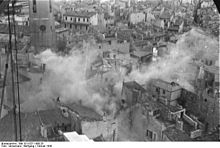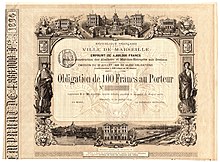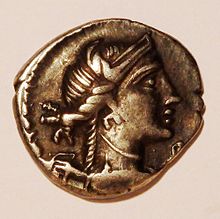Marseille
![]()
The title of this article is ambiguous. For other meanings, see Marseille (disambiguation).
Template:Infobox commune in France/maintenance/alternate coat of arms in Wikidata
Marseille [maʁˈsɛj] (German obsolete: Massilien, Occitan: Marselha or Marsiho [maʀˈse.jɔ]) is a major French city with 868,277 inhabitants (1 January 2018) and the capital of the Bouches-du-Rhône department and the Provence-Alpes-Côte d'Azur region. It is the most important French and a major European port city on the Golfe du Lion, a Mediterranean bay.
Marseille is the second largest city in France after Paris. Along with Aix-ein-Provence, Marseille is one of the two core cities of the Métropole d'Aix-Marseille-Provence with 1,878,061 inhabitants. The metropolitan region has about 3.05 million inhabitants (2015), as defined by Eurostat. The inhabitants call themselves Marseillais [maʁ.sɛ.ˈjɛ].
Marseille was European Capital of Culture in 2013 together with the Slovakian city of Košice.
Geography
Marseille lies between 0 and 652 m (12 m at the official centre Noailles) high. The 240 km² urban area (more than twice the size of Paris) includes, in addition to the built-up area, vast natural areas, mainly mountains. The city is bordered on the west by the Mediterranean Sea, on the north by the mountains Chaîne de l'Estaque and Chaîne de l'Etoile (with the summit of l'Etoile as the highest point of the city), on the east by the Garlaban massif, on the southeast by the Saint-Cyr massif and on the south, the Massif des Calanques again on the Mediterranean Sea.
Due to its location, Marseille has a Mediterranean climate that is very sunny and has little rain. The reason for this are also the often strong winds, especially the Mistral, which is why the climate can sometimes be harsh despite the southern location.
| Marseille | ||||||||||||||||||||||||||||||||||||||||||||||||
| Climate diagram | ||||||||||||||||||||||||||||||||||||||||||||||||
| ||||||||||||||||||||||||||||||||||||||||||||||||
| Monthly average temperatures and precipitation for Marseille
Source: wetterkontor.de | ||||||||||||||||||||||||||||||||||||||||||||||||||||||||||||||||||||||||||||||||||||||||||||||||||||||||||||||||||||||||||||||||||||||||||||||||||||||||||||||||||||||||||||||||||||||||||||||||||||||||||||||||||||||||||||||||||||||||||||||||||||||||||||||||||||||||||||||||||||||||||
History
Legend of the city foundation
According to ancient legend, the city was founded when Greek sailors explored the Mediterranean coast. They landed on the coast of what is now Marseille on the day when a Celtic king named Nann was looking for a husband for his daughter Gyptis. Gyptis was to hand a goblet to the one she wished to marry from among all the young men gathered. Surprisingly, it was Protis, the leader of the newcomers, to whom she handed the vessel. The two married, and Greeks and Celts founded the settlement of Massalia together.
Ancient Greek trading post
Greek sea traders from Phocaea in Asia Minor regularly visited the southern coast of France near the mouth of the Rhône in the 7th century BC to trade with the Ligurian tribes. Tin in particular, as a component of bronze, was coveted by the Greeks. In return, fine pottery and jewelry found their way into the homes of local princes. On the rugged and rocky coast, protected landing places were rare, so one headed for the natural harbour of today's Marseille, where the galleys were protected from wind and waves.
Around 620-600 BC, Greeks founded a permanently inhabited settlement (apoikia) at this port thanks to a gift of land from the Ligurian princes and named it Massalia (Greek Μασσαλία, Latin Massilia), today's Marseille.
Greek polis
The polis soon grew into one of the richest and largest Greek apoikia in the western Mediterranean, which, with its connection to the natural trade route of the Rhône, had cultural influence far into the hinterland. Evidence of this influence is the use of Greek letters by the Helvetians in Caesar's time. Greek influence may also have survived in some southern French dialects, according to some researchers.
Malaga, Corsica and Nice were also settled by Greeks from Phocaea, who founded one apoikia after another. In time, Massalia became so large and important that it sent out settlers of its own to establish trading posts and cities as far west as Spain. The expansion of the Phocaeans and Massaliots was put to an end by a coalition of Etruscans and Carthaginians at the naval battle of Alalia.
The late antique author Stephanos of Byzantium mentions several towns or settlements founded by Massalia in the surrounding countryside, which are otherwise not attested:
- Alonis (Ἀλωνίς)
- Azania (Ἀζανία)
- Cyrene (Κυρήνη), possibly La Couronne near Martigues.
- Sekoanos (Σηκοανός), probably a river, possibly Arc or Touloubre.
Around the year 545 BC, according to Herodotus, immigrants from Phocaea again arrived in the city. They had fled after Harpagos, commander of King Cyrus II of Persia, had conquered Phocaea.
There were repeated conflicts with the Celtic tribes dominating Gaul. In 125 BC Massalia called the troops of the Roman Empire for help against the attacks of Gallic tribes (Ligurians, Allobroges, Salluvians, Arvernians and Vokontians). In the course of the warfare, the entire territory of southern Gaul was annexed by the Romans as the province of Gallia Narbonensis. The city itself, however, initially remained an ally of Rome and was able to maintain its independence for several decades. During the years of the civil war between Julius Caesar and Gnaeus Pompeius, Massalia wanted to remain neutral, but this was not tolerated by Caesar. In 49 BC, after a six-month siege, the city was finally conquered and soon after integrated into the province of Narbonensis. Thus, it remained part of the Roman Empire until its end and now gradually lost its Greek character.
In 314, the first known bishop of Massilia Oresius is mentioned in the document of the Council of Arelate. At the beginning of the 5th century AD, the monastery of Saint-Victor was founded on the south bank of the Old Port, which was to be the residence of the bishops of Marseille from 750 to 960. In 481 the city fell to the Visigoths, in 508 to the Ostrogoths, and in 536 to the Franks.
Middle Ages and Early Modern Times
In 879, the town fell to Lower Burgundy. After the Saracens destroyed it, the city was rebuilt in the 10th century and placed under the authority of the Vicomtes de Marseille. Between 1216 and 1218, Marseille became an independent republic and was finally united with France in 1481.
It is considered certain that the Black Death was introduced to Western Europe via Marseille in the 14th century. In 1720 and 1721, the last major outbreak of the plague killed 50,000 people, half the population of Marseille. In connection with this serious epidemic, a military command, a "plague police", was placed by the king at the side of the city councillors to deal with the situation. The city thus had a double command. The city was divided into different areas to ensure surveillance and reduce the risk of infection.
The people of Marseille have always been proud and independent and were known throughout the country for their love of rebelling against the authorities and the king. So in 1792, the city sent 500 volunteer fighters to support the new government during the French Revolution. The song sung by the Marseille fighters in the streets of Paris became known as the Marseillaise. On July 14, 1795, the Marseillaise was declared the French national anthem.
Modern Times
In the 19th century, Marseille grew to become the most important port in France, mainly because of French colonization in Africa and Indochina. The development and importance of the port increased with the beginning of industrialization and the opening of the Suez Canal in 1869.
On 9 October 1934, Yugoslav King Alexander I and French Foreign Minister Louis Barthou fell victim to an assassination attempt by an assassin of the Croatian nationalist Ustasha movement in front of the Stock Exchange. In the interwar period, criminal networks of the Corsican mafia gained influence over local politics. The extent of corruption became visible in the fire of the Nouvelles Galeries department store on October 28, 1938, in which the municipal fire brigade failed and 73 people died. The mayor was forced to resign and Prime Minister Édouard Daladier placed Marseille under receivership of the central government. This affair also became synonymous with the moral depravity of the political elite in the final years of the Third Republic.
After the surrender of the armed forces of France in the Second World War to the Wehrmacht, Marseille initially belonged to the Zone libre, which was under the administration of the Vichy regime. Between November 1942 and August 1944 (Operation Dragoon), Marseille was occupied by German troops. In January and February 1943, following Himmler's orders, a large part of the historic old town (Vieux Port) was blown up by troops of the Wehrmacht and the Waffen-SS, with the participation of Rolf Mühler and Günter Hellwing. 27,000 inhabitants were forcibly relocated from the old town, which the occupying forces considered a stronghold of the Resistance (Himmler had demanded 100,000 deportees). 1,640 inhabitants of the city, including about 800 Jews, were arrested as "undesirable and anti-social elements" and later deported to Reich territory or Poland.
Buildings were destroyed during the demolition of the old town in 1924. Some of the perpetrators were charged with these war crimes in the 1954 trials of Mühler and others, as well as of Carl Oberg and others; several were sentenced to death in absentia without the French justice system being able to arrest them: The Federal Republic did not extradite them and did not indict them itself. Thus, this war crime was never atoned for.
Hitler designated all important port cities in the west - including Marseille - as "fortresses" in the first quarter of 1944.
On 27 May 1944, American bombers attacked the German military installations in Marseille. On 28 August, after a week of fighting, the German occupiers surrendered to Free France troops.
The defenders did not fight as fanatically as demanded, for example, in OKW orders of February 1944 for the defense of fortresses. These ordered to fight "to the last man" and not to surrender under any circumstances.
Present
In the strong economic boom of the post-war period (trentes glorieuses), the city continued to grow and after Algerian independence in 1962, tens of thousands of Algerian French (pieds-noirs) who had to leave the country settled in Marseille. Housing estates were built for them in the north of the city. From the 1970s onwards, considerable problems arose with the simultaneous decline of traditional industries due to structural change, uncontrolled immigration, increasing crime, pollution and growing traffic. In 1973, a wave of racist riots against Algerian immigrants killed up to 100 people and caused horror among the French public. Marseille lost 10% of its population in ten years through emigration, including to the suburbs, where the wealthier residents settled. During this period, the mayors made great efforts to deal with crime, the large number of illegal immigrants from North Africa and the city's decay. Young people from the city's socially deprived areas gave birth to French hip-hop in the 1980s.
Since the 1990s, the image of the city has been slowly changing. With the Euromediterrannée urban renewal project, large state funds were invested in the Marseille economy. Old industrial buildings have been dedicated to cultural purposes, and private investors such as the American pension fund Lone Star have been involved in the project to urbanise the Rue de la République, the boulevard created during the Second Empire. The city is making great efforts to beautify the cityscape, but is also confronted with the criticism that gentrification is driving the less affluent city dwellers out of the centre.

The old port of Marseille, 2011

Destruction of the old harbour quarter 1943

Announcements of 4 January 1943 by the Commandant on the State of Siege

Notre-Dame De La Garde

Bond of the city of Marseille dated 20 July 1894, blank chain

Back of the drachma, lion and writing

Drachm from Massalia, head of Artemis, minted after 200 B.C.

Marseille in 1575

Historical map of Marseille, year 1888
Search within the encyclopedia